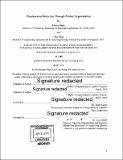| dc.contributor.advisor | André Carrel. | en_US |
| dc.contributor.author | Rajan, Ranjani | en_US |
| dc.contributor.author | Wang, Ying | en_US |
| dc.contributor.other | Massachusetts Institute of Technology. Engineering Systems Division. | en_US |
| dc.date.accessioned | 2017-03-20T19:37:45Z | |
| dc.date.available | 2017-03-20T19:37:45Z | |
| dc.date.copyright | 2016 | en_US |
| dc.date.issued | 2016 | en_US |
| dc.identifier.uri | http://hdl.handle.net/1721.1/107511 | |
| dc.description | Thesis: M. Eng. in Logistics, Massachusetts Institute of Technology, Supply Chain Management Program, 2016. | en_US |
| dc.description | Cataloged from PDF version of thesis. | en_US |
| dc.description | Includes bibliographical references (pages 71-72). | en_US |
| dc.description.abstract | The Hershey Company faces a risk of obsolescence across its supply chain as it follows the First In First Out (FIFO) technique at its manufacturing plant distribution center instead of distributing goods based on either the demand at each retailer's end or the useable shelf life of the goods being distributed. The two different stages at which a product can turn obsolete are a) when it reaches expiry and b) during the end of a season or promotion run for a specialty product. The existing picking strategy does not differentiate between orders based on the type of products or the volume served by destination/retailers. This could lead to the risk of obsolescence or return of products in some retailers as the products reach expiry before sales at the retailer's end due to insufficient remaining shelf life. Through this project, we aim at reducing the total obsolescence of a product by proposing a new picking strategy based on the sales volume at each distribution channel and the remaining shelf life of products at the manufacturer's site. The cut-off value or the ratio of volume served by fast moving customer distribution centers to the total volume at which the obsolescence within the supply chain would be minimal was determined for a set of products using an excel simulation model. Hierarchical clustering was performed on all products to form two clusters of distribution centers based on the shipped order quantities and the fractional volume served by both the clusters was determined. The new model was proposed for those product-distribution center combinations with fractional volumes greater than the cut-off as they are most likely to benefit with reduced level of obsoletes. | en_US |
| dc.description.statementofresponsibility | by Ranjani Rajan and Ying Wang. | en_US |
| dc.format.extent | 78 pages | en_US |
| dc.language.iso | eng | en_US |
| dc.publisher | Massachusetts Institute of Technology | en_US |
| dc.rights | MIT theses may be protected by copyright. Please reuse MIT thesis content according to the MIT Libraries Permissions Policy, which is available through the URL provided. | en_US |
| dc.rights.uri | http://dspace.mit.edu/handle/1721.1/7582 | en_US |
| dc.subject | Supply Chain Management Program. | en_US |
| dc.subject | Engineering Systems Division. | en_US |
| dc.title | Obsolescence reduction through product segmentation | en_US |
| dc.type | Thesis | en_US |
| dc.description.degree | M. Eng. in Logistics | en_US |
| dc.contributor.department | Massachusetts Institute of Technology. Supply Chain Management Program | |
| dc.identifier.oclc | 962731074 | en_US |
